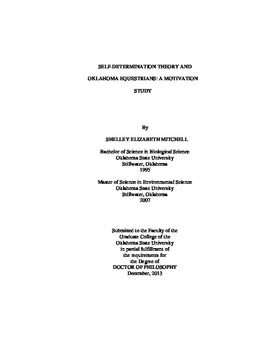| dc.contributor.advisor | Caneday, Lowell | |
| dc.contributor.author | Mitchell, Shelley Elizabeth | |
| dc.date.accessioned | 2015-06-17T20:07:07Z | |
| dc.date.available | 2015-06-17T20:07:07Z | |
| dc.date.issued | 2013-12 | |
| dc.identifier.uri | https://hdl.handle.net/11244/19486 | |
| dc.description.abstract | The purpose of this study was to determine the characteristics of Oklahoma equestrians and their motivation(s) for leisure riding, as well as compare equivalent-form reliability between the Sport Motivation Scale (SMS) and the revised Sport Motivation Scale (SMS-II). Self-determination theory (SDT) was the basis of the study and the survey instruments. An online survey available from February through August of 2013 was completed by 195 riders, with 186 usable surveys. Nonparametric statistics were used to analyze responses, as assumptions for parametric statistics were not met. Responding Oklahoma equestrians were primarily female, ride mainly for fun, and have been riding horses for over 21 years. A third of the respondents were aged 50 to 59 years. Eighty percent ride Western style; two-thirds of the respondents have families involved with horses and two-thirds of the respondents also ride once or twice a week. Half of the responding equestrians came from households earning $25,001 to $75,000 a year before taxes. Responding Oklahoma equestrians ride primarily for fun and accomplishment, with few riding primarily to gain more knowledge of the activity. Riders in this study were primarily intrinsically motivated, followed by extrinsically motivated at the identified level, based on the autonomy continuum as described by SDT. In general, overall motivation (as measured by an overall SDT score) increases as frequency of riding increases. The SMS and SMS-II are significantly different in all subscales measured on both instruments. The original SMS does not measure the integrated level of extrinsic motivation and also gives more weight to the measure of intrinsic motivation, because it measures three separate levels of it. The revised SMS (SMS-II) not only adds a measure for integrated regulation, but also measures intrinsic motivation in general, giving intrinsic motivation a more appropriate degree of influence on the overall SDT score. The SMS-II is the instrument recommended for further studies, although the three separate measures of intrinsic motivation from the original SMS are still useful in determining what kinds of intrinsic motivation are at play within an individual. | |
| dc.format | application/pdf | |
| dc.language | en_US | |
| dc.rights | Copyright is held by the author who has granted the Oklahoma State University Library the non-exclusive right to share this material in its institutional repository. Contact Digital Library Services at lib-dls@okstate.edu or 405-744-9161 for the permission policy on the use, reproduction or distribution of this material. | |
| dc.title | Self-determination theory and Oklahoma equestrians: A motivation study | |
| dc.contributor.committeeMember | Tapps, Tyler Nicholas | |
| dc.contributor.committeeMember | Lindenmeier, Donna | |
| dc.contributor.committeeMember | Payton, Mark E. | |
| osu.filename | Mitchell_okstate_0664D_13040.pdf | |
| osu.accesstype | Open Access | |
| dc.type.genre | Dissertation | |
| dc.type.material | Text | |
| thesis.degree.discipline | Health, Leisure, and Human Performance | |
| thesis.degree.grantor | Oklahoma State University | |
